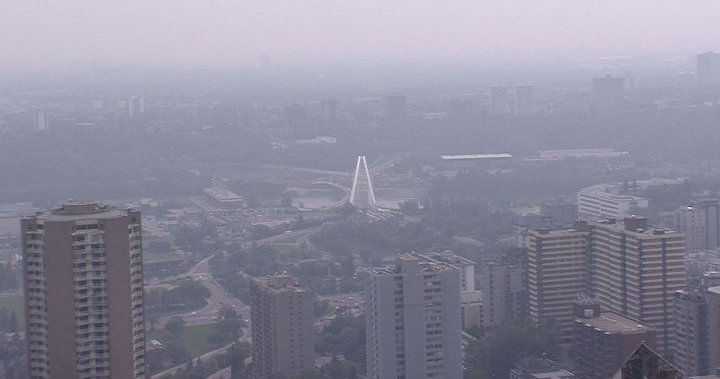A special air quality statement has been issued for the City of Edmonton and surrounding areas due to wildfire smoke that has drifted into the region from northeastern British Columbia, causing poor air quality and reduced visibility. The Air Quality Health Index (AQHI) for Edmonton was at a high risk level of 10 when the statement was issued at 8 a.m. on Saturday, with a forecast to peak at a very high risk level of 10+ by Saturday night. Conditions are expected to gradually improve over eastern parts of the province by Saturday night, with other regions seeing some improvement by Sunday afternoon. However, in northwestern Alberta, poor air quality conditions are expected to persist through Monday or Tuesday. Special air quality statements have been issued for Strathcona County, St. Albert, Lamont County, Sturgeon County, Drayton Valley, and Edson.
Air quality alerts are also in effect for most of the northern half of the province where two wildfires are currently burning. AQHI values for the Grande Prairie and Fort McMurray regions are expected to peak at a very high risk level of 10+ on Saturday. The statement emphasized that wildfire smoke can be harmful to everyone’s health, even at low concentrations, and advised everyone to take action to reduce their exposure to the smoke. People with respiratory challenges such as asthma, those with heart disease, children, older adults, and pregnant individuals are specifically advised to stay indoors to reduce the risks associated with poor air quality.
The statement highlights the importance of taking precautionary measures to protect one’s health during periods of poor air quality caused by wildfire smoke. It stresses that everyone can take steps to reduce their exposure to the smoke and minimize the health risks associated with it. Individuals are urged to stay indoors, especially those with respiratory issues, heart disease, children, older adults, and pregnant individuals. The air quality alerts and special statements issued for various regions in the province indicate the severity of the situation and the need for heightened awareness and caution. The forecasted peak in AQHI levels for certain areas underscores the potential dangers of prolonged exposure to wildfire smoke.
The article warns that wildfire smoke can have detrimental effects on health, emphasizing that it can be harmful even at low concentrations. This highlights the urgency of addressing air quality issues caused by wildfires and taking steps to protect vulnerable populations, including those with pre-existing health conditions. The AQHI values reaching very high risk levels in certain regions indicate the severity of the air quality situation and the potential impact on public health. The recommendations to stay indoors, especially for individuals at higher risk, are crucial in minimizing exposure to harmful pollutants in the air.
Overall, the special air quality statement issued for the City of Edmonton and surrounding areas due to wildfire smoke emphasizes the importance of being proactive in protecting one’s health during periods of poor air quality. The alert serves as a reminder for individuals to take necessary precautions, especially those with respiratory challenges, heart disease, children, older adults, and pregnant individuals. The ongoing monitoring of air quality levels and forecasts, as well as the issuance of alerts and statements in various regions, highlight the need for heightened awareness and preparedness to mitigate the risks associated with wildfires and their impact on air quality. It is essential for everyone to be informed and take appropriate actions to safeguard their health and well-being during such environmental challenges.


